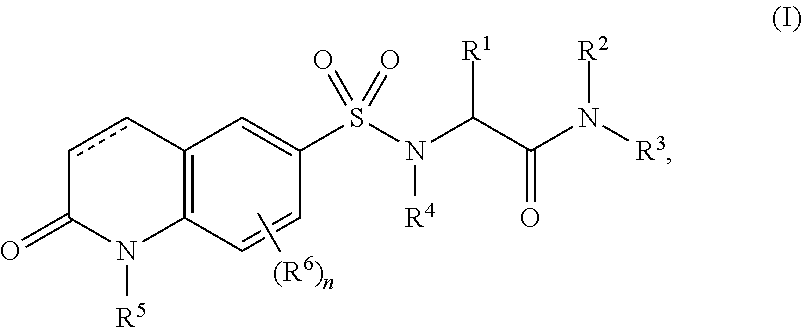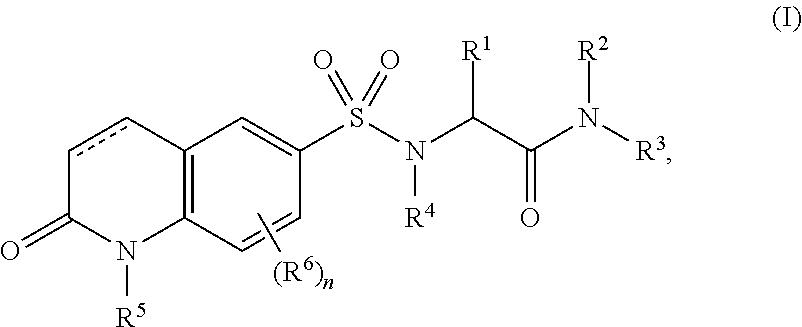O-glcnac transferase inhibitors and uses thereof
- Summary
- Abstract
- Description
- Claims
- Application Information
AI Technical Summary
Benefits of technology
Problems solved by technology
Method used
Image
Examples
example 1
General Procedure for Synthesizing Quinolinesulfonamides
[0147]Compounds of the invention are prepared according to the schemes, steps, and intermediates described below.
A) chlorosulfonic acid, 65° C.; B) NaOH, H2O; C) HATU, DIEA, DMF.
[0148]Step-1
[0149]The mixture of 5 g of quinolin-2(1H)-one in 15 ml of chlorosulfonic acid was heated at 65° C. for 3 h. After cooling to RT, the mixture was poured over ice (˜150 ml). The precipitate was filtered and the filter cake was washed with water. The product was dried under vacuum overnight to yield a light brown solid (5.1 g, 61%). MS and 1H-NMR are consistent with structure.
[0150]Step-2
[0151]To a stirred solution of D,L-phenylalanine (149 mg, 0.98 mmol) and sodium hydroxide (98 mg, 2.45 mmol) in water (10 ml) was added 2 in one portion (200 mg, 0.82 mmol). The reaction mixture was stirred at room temperature for 22 hours and the remaining insoluble material was filtered off (celite) and washed with water. The combined filtrate and washing wa...
example 2
Preparation of N-(2-(4-methylpiperazin-1-yl)-2-oxo-1-phenylethyl)-2-oxo-1,2-dihydroquinoline-6-sulfonamide
[0154]
[0155]The title compound was prepared according to the schemes, steps, and intermediates in Example 1, using 1-methylpiperazine as the amine. After removal of the reaction solvent, the crude product was washed with water and EtOAc (deviation from general workup) to give a gray, amorphous solid in 69% yield. MS (APCI): (M+1)+=441; HPLC: 99% purity (C-18, RT=4.42 mins.); 1H-NMR is consistent with structure.
example 3
Preparation of N-(furan-2-ylmethyl)-2-(2-oxo-1,2-dihydroquinoline-6-sulfonamido)-2-phenyl-N-(thiophen-2-ylmethyl)acetamide
[0156]
[0157]The title compound was prepared according to the schemes, steps, and intermediates in Example 1, using furan-2-ylmethyl-thiophen-2-ylmethylamine as the amine. The product was purified by flash chromatography (silica gel 60, 230-400 mesh) using EtOAc as eluent. The purified product was isolated as an orange oil which solidified on standing. Trituration with cold EtOAc gave a light yellow solid in 13% yield. MS (APCI): (M+1)+=534; HPLC: 97.4% purity (C-18, RT=5.00 mins.); 1H-NMR is consistent with structure.
Preparation of furan-2-ylmethyl-thiophen-2-ylmethylamine
[0158]
[0159]A mixture of furfurylamine (2.0 g, 0.0206 mol) and 2-thiophenecarboxaldehyde (2.31 g, 0.0206 mol) in dichloromethane (60 ml) was stirred at room temperature for 5 minutes before adding portionwise sodium triacetoxyborohydride (5.24 g, 0.0247 mol). After addition was complete (approx....
PUM
| Property | Measurement | Unit |
|---|---|---|
| Pharmaceutically acceptable | aaaaa | aaaaa |
Abstract
Description
Claims
Application Information
 Login to View More
Login to View More - R&D
- Intellectual Property
- Life Sciences
- Materials
- Tech Scout
- Unparalleled Data Quality
- Higher Quality Content
- 60% Fewer Hallucinations
Browse by: Latest US Patents, China's latest patents, Technical Efficacy Thesaurus, Application Domain, Technology Topic, Popular Technical Reports.
© 2025 PatSnap. All rights reserved.Legal|Privacy policy|Modern Slavery Act Transparency Statement|Sitemap|About US| Contact US: help@patsnap.com



